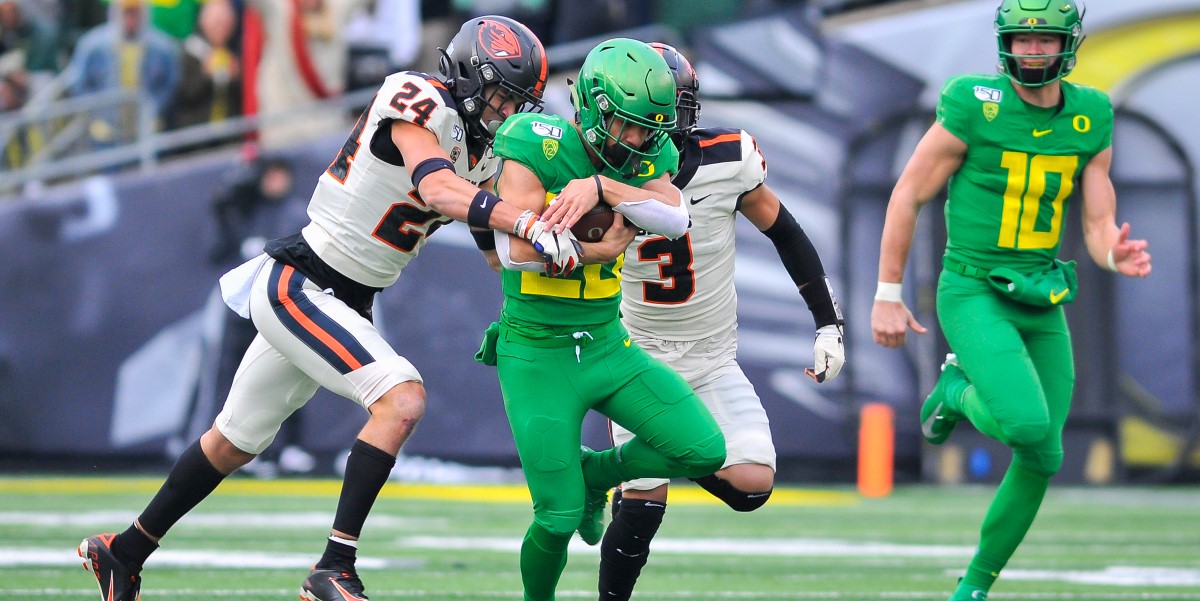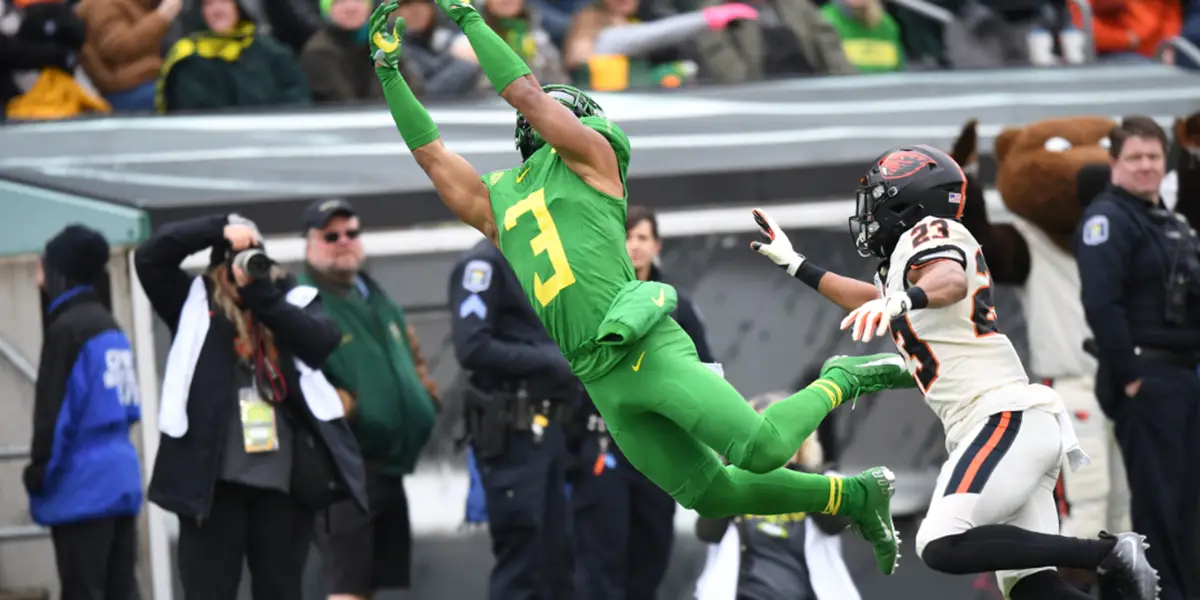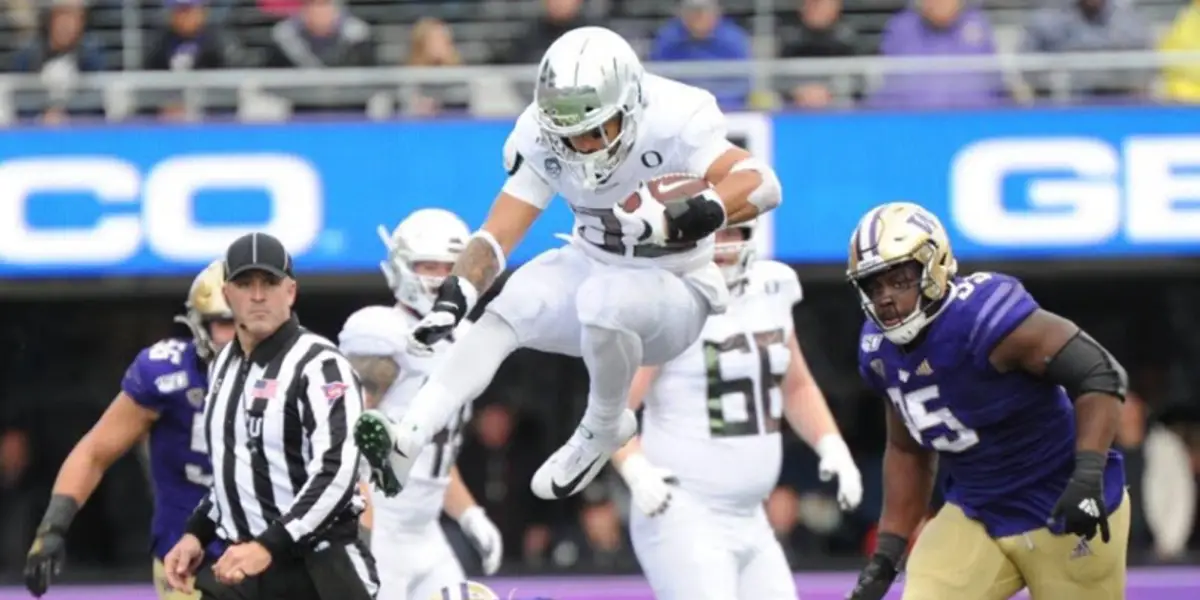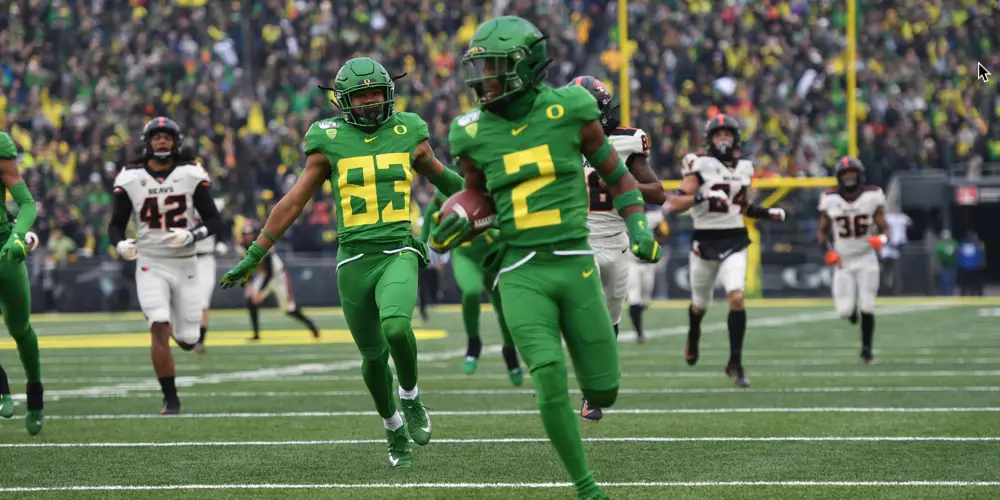The Oregon Ducks are on a three-game winning streak!
The 2016 season saw the Oregon Ducks lose their first Civil War since… 2007! But in the three games since, the Mario Cristobal-led Ducks outscored the lowly Oregon State Beavers 148-35. All three seasons saw the dominant Ducks hold Oregon State to 15 or fewer points, while the Ducks scored at least 24 points.
While it may seem that the Ducks have obliterated the Beavers, and the scores certainly indicate that they have, the three games paint another picture. The scores have grown closer in each season following the Ducks’ eight-game winning streak, and the Ducks struggled to move the ball more against the Beavers than almost any other opponent in 2019.
So, how is Oregon State setting up to beat the Ducks, and what can Oregon do to keep its series dominance going?
The Beavers are Catching Up

The Beavers will need to get better defensively to beat Oregon in the coming years.
During the Gary Andersen era, the Oregon State Beavers fell off the proverbial cliff. While Mike Riley made the Beavers competitive in his second stint in Corvallis, Andersen failed to recruit or develop players on either side of the ball. He left the cabinet bare, despite beating the Ducks in his final win as the Beavers’ head coach.
Jonathan Smith took over an awful situation. Oregon State went 1-11 the season before he arrived, and the first-time head coach had to find an identity for the program. The school had finished in the bottom three teams in the conference in each of the previous six seasons, and Andersen’s failure to develop the remaining talent on the team left the Beavers with arguably the worst offense and the worst defense in FBS football.
During his first off-season, Smith grew a recruiting class that was threatening to be ranked in the triple digits to a respectable, if not groundbreaking, 70th place nationally. More importantly the coach started signing players that fit a run-and-shoot style.

Johnny Johnson III showed the type of player development that the Oregon State staff will try to emulate.
Jermar Jefferson was undeniably the most dominant freshman running back in the Pac-12 in Smith’s first season. Several players from the 2018 class got immediate playing time on the interior of the offensive and defensive lines, as well as in the middle of the defense.
But Smith didn’t recruit at a much higher level than his predecessor. With his first three classes ranking in the bottom three in the conference, Smith has still managed to turn the worst top-to-bottom roster in the conference into a competitive bunch. He has done so by using the newly-adopted transfer portal to greater effect than perhaps any other team in the NCAA.
Smith has added impact players all over the field, particularly on the defensive side of the ball. His attacking of the transfer marketin conjunction with his heavy recruitment of junior college players took a roster that would struggle to compete with most FCS teams, and made it in to a roster that was good for second in the Pac-12 North in 2019.
A 2020 recruiting class that was good for 52nd in the nation, despite being ranked only 9th in the conference, brings another crop of talented players in to the mix, including several larger defensive backs that will no doubt hassle wide receivers across the conference.
On top of all the player acquisition, Smith has done what Riley was known for and Andersen failed to do: develop players. Smith and his staff helped develop several unknown or underperforming players into major contributors in 2018 and 2019, and with the influx of talent, his rosters will be dangerous for years to come.
Better players are only half of the battle, as Smith possesses a trait that goes underappreciated in modern college football — he builds effective game plans. While the rest of the country takes part in an arms race for the best recruiting coordinator playing head coach, Smith remains an excellent game planner.
Added together, the future is bright for the Beavers. They are unlikely to compete for national championships while recruiting mid-level, three-star players, but they can certainly beat the Ducks as they have in years past.
How the Ducks Can Survive

Hibiki-Likio becomes important piece for Ducks in second half.
After five years of a swift fall and a just-as-swift rise, the Ducks won the Pac-12 in 2019. They proceeded to win the first Rose Bowl of the 2020s and signed their second consecutive No. 1 class in the conference.
The next step is the CFP Playoff, right? WRONG! The next step is maintaining their dominance over the Beavers! Nothing short of an off-season full of one of the NCAA’s best strength and conditioning programs, along with putting in the requisite work on the field, will keep the Ducks winning at the highest level.
That is what Cristobal and his merry band of go-getters will say. They’ll say it every year between now and the time they finally leave Eugene, because that is the culture they have instilled in the Pacific Northwest. They should keep saying it, as that sort of rhetoric won the conference, the Rose Bowl, conference recruiting champion titles and so many awards for the team.
To stay ahead of the Beavers, the Ducks need only to continue to outwork them in every facet of the program. Keep recruiting bigger, stronger and faster players. Keep pushing the team like they just went 4-8. Keep winning games, and there isn’t a team in the state of Oregon or the country at large that can stand in their way.
Ryan Robertson
Yuma, ArizonaTop Photo Credit: Tom Corno
 Natalie Liebhaber, the FishDuck.com Volunteer Editor for this article, works in the financial technology industry in Bozeman, Montana.
Natalie Liebhaber, the FishDuck.com Volunteer Editor for this article, works in the financial technology industry in Bozeman, Montana.
Related Articles:
Oregon Enters Playoffs Better Off Than Last Year
Will The Coaching Carousel Kill Oregon's CFP Chances?
The Playoff Formula Hasn't Changed
Oregon Aims to Bury Dawgs, Punch Playoff Ticket in Rivalry Clash
Huskies Are the New Beavers, Stay In Your Lane Kiffin, and the Civil Apple Cup War
Oregon Football: The X-Factor Vs. Washington
Ryan Robertson is a defense contractor for the United States Marine Corps. A lifelong Duck fan from Grants Pass, he joined the Army out of high school. After four years as an Intelligence Analyst he decided it was time to further his education and pay more attention to his Ducks. One of Ryan’s first memories is of watching the Ducks, led by Joey Harrington, beating up on the Utah Utes in 2001. His grandfather ran track at Oregon in the ‘50s. He loves the Ducks, and has a passionate interest in reading every scrap of analysis centered around the football team.

